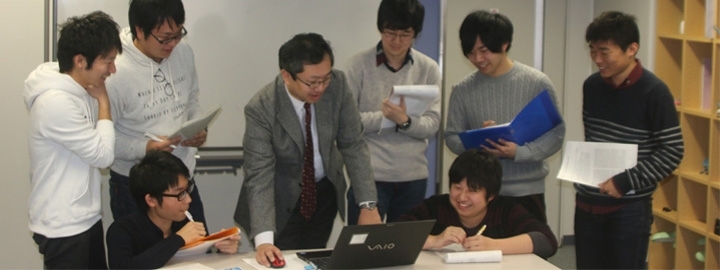Applied Mathematics and Physics Division

Overview
In addition to developing mathematical engineers who can work with phenomena from microscales to macroscales based on conventional mathematics, physics, and programming, the department educates and conducts research in the fields of advanced mathematical modeling, designing new materials by computer simulation, applying basic and developmental theories to elucidate physical phenomena with in-depth understandings of mathematics, physics, and computer science. Our goal is also to develop engineers who are capable of addressing information technologies and robotics utilized in real-world industries.
Laboratory introduction
For faculty member details, please see the staff introductions.
| Laboratory |
Theory of differential Equations |
|---|
| Faculty members |
Associate professor Naoto Kajiwara |
|---|
| Research details |
In our laboratory, we study the solvability of differential equations and the behavior of their solutions. I would like to obtain quantitative and qualitative information from equations using functional analytic methods and real analytic methods. I am also interested in abstract theories such as analytic semigroup theory and maximal regularity theory. |
|---|
| Laboratory |
Theory of differential Equations |
|---|
| Faculty members |
Associate professor KATO Tomoya |
|---|
| Research details |
My research area is Fourier analysis and its application to partial differential equations. Modulation spaces are function spaces introduced from the viewpoint of time-frequency analysis and are known that give new phenomena on Fourier analysis. In the framework of modulation spaces, I study on the boundedness of pseudo-differential operators in the field of Fourier analysis area and the initial value problem for nonlinear dispersive equations in the field of partial differential equations. In the future, I wish I could develop or improve known results by using this function spaces. |
|---|
| Laboratory |
Dynamical systems theory |
|---|
| Faculty members |
Professor KAMEYAMA Atsushi |
|---|
| Research details |
In the field of mathematics referred to as dynamical systems, our laboratory conducts research especially of complex dynamics, reduced-dimensional systems, and fractals from topological and combinatorial viewpoints. Currently, we are engaged in coding with Julia sets of symbolic dynamics and analyzing parameter space dynamics of rational functions using this coding. |
|---|
| Laboratory |
Solid State Physics |
|---|
| Faculty members |
Professor KUBO Osamu |
|---|
| Research details |
Under construction. |
|---|
| Laboratory |
Partial differential equations, plasmas, reaction-diffusion equations |
|---|
| Faculty members |
Professor KONDO Shintaro |
|---|
| Research details |
My specialty is the mathematical analyses of nonlinear partial differential equations. Our laboratory has been conducting the study of mathematical analyses of partial differential equations and ordinary differential equations that describe the turbulent flow phenomena of plasma fusion. Recently, we are engaged in research to understand biological issues with the use of reaction-diffusion equations. Also, we have been working to elucidate misperception phenomena through modeling and mathematical analyses of a hierarchical model of the retina based on control mechanisms by "darkening bright areas and brightening dark areas." |
|---|
| Laboratory |
Space science laboratory (radio astronomy) |
|---|
| Faculty members |
Associate professor SANO Hidetoshi
Assistant professor MURASE Takeru
Assistant professor TSUGE Kisetsu |
|---|
| Research details |
Our laboratory conducts observational research in radio astronomy. We are working primarily to observe water maser radio waves around a fixed star using an 11m radio telescope installed at the campus of Gifu University, software development for data analyses, and the study of black holes in galactic nuclei with the VLBI (very long baseline interferometry) observation method. Additionally, we are utilizing cutting-edge telescopes such as the Atacama Large Millimeter/submillimeter Array (ALMA) telescope, XRISM X-ray astronomy satellites, and The CTA gamma-ray telescopes to explore the longstanding challenges in modern astrophysics such as the origin of cosmic rays and the mechanisms underlying the formation of massive star clusters. |
|---|
| Laboratory |
Computational physics engineering |
|---|
| Faculty members |
Professor TERAO Takamichi |
|---|
| Research details |
Our laboratory conducts research of the development of computer simulation techniques suitable for metamaterial composites and their applications. From the viewpoint of computational science, we are engaged in the prediction of physical properties in microparticle-related systems, and molecular simulations to clarify the order of formation. |
|---|
| Laboratory |
Nitta laboratory |
|---|
| Faculty members |
Professor NITTA Takahiro |
|---|
| Research details |
Our laboratory studies: (1) biomolecular motors, and (2) sliding friction.
(1) With the goal of applying a biomolecular motor to biosensors and microrobots, and understanding biological systems through comparisons with artifacts such as machines, we are currently engaged in experimentation and computer simulations.
(2) With the goal of understanding sliding friction on a macroscopic scale, we are particularly focusing on developing a method for in-situ observations of friction interfaces. |
|---|
| Laboratory |
Minami laboratory |
|---|
| Faculty members |
Assistant professor MINAMI Yuki |
|---|
| Research details |
Under Construction. |
|---|
| Laboratory |
Additive processes |
|---|
| Faculty members |
Professor YAMAMURO Kouji |
|---|
| Research details |
Our research field covers stochastic processes, and in particular, additive processes based on probability theory from the perspective of measurement theory. Additive processes are rich mathematical objects, and typically include Brownian motion, Poisson processes, and stability processes. The study of additive processes assumes a basic role in the study of stochastic processes. |
|---|


